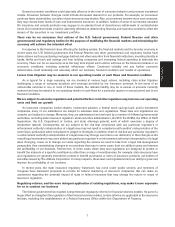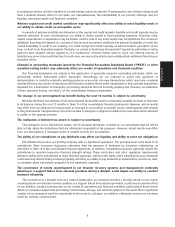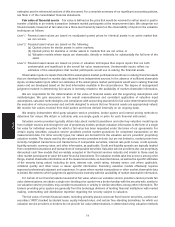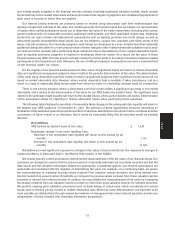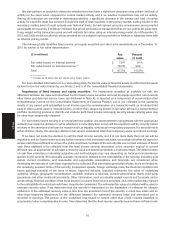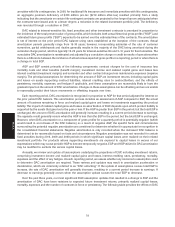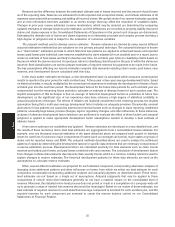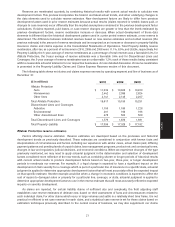Allstate 2011 Annual Report Download - page 97
Download and view the complete annual report
Please find page 97 of the 2011 Allstate annual report below. You can navigate through the pages in the report by either clicking on the pages listed below, or by using the keyword search tool below to find specific information within the annual report.
flow or other information to estimate a recovery value for the security, we may conclude that the entire decline in fair
value is deemed to be credit related and the loss is recorded in earnings.
There are a number of assumptions and estimates inherent in evaluating impairments of equity securities and
determining if they are other than temporary, including: 1) our ability and intent to hold the investment for a period of
time sufficient to allow for an anticipated recovery in value; 2) the length of time and extent to which the fair value has
been less than cost; 3) the financial condition, near-term and long-term prospects of the issue or issuer, including
relevant industry specific market conditions and trends, geographic location and implications of rating agency actions
and offering prices; and 4) the specific reasons that a security is in an unrealized loss position, including overall market
conditions which could affect liquidity.
Once assumptions and estimates are made, any number of changes in facts and circumstances could cause us to
subsequently determine that a fixed income or equity security is other-than-temporarily impaired, including: 1) general
economic conditions that are worse than previously forecasted or that have a greater adverse effect on a particular
issuer or industry sector than originally estimated; 2) changes in the facts and circumstances related to a particular
issue or issuer’s ability to meet all of its contractual obligations; and 3) changes in facts and circumstances that result in
changes to management’s intent to sell or result in our assessment that it is more likely than not we will be required to
sell before recovery of the amortized cost basis of a fixed income security or causes a change in our ability or intent to
hold an equity security until it recovers in value. Changes in assumptions, facts and circumstances could result in
additional charges to earnings in future periods to the extent that losses are realized. The charge to earnings, while
potentially significant to net income, would not have a significant effect on shareholders’ equity, since our securities are
designated as available for sale and carried at fair value and as a result, any related unrealized loss, net of deferred
income taxes and related DAC, deferred sales inducement costs (‘‘DSI’’) and reserves for life-contingent contract
benefits, would already be reflected as a component of accumulated other comprehensive income in shareholders’
equity.
The determination of the amount of other-than-temporary impairment is an inherently subjective process based on
periodic evaluation of the factors described above. Such evaluations and assessments are revised as conditions change
and new information becomes available. We update our evaluations regularly and reflect changes in
other-than-temporary impairments in results of operations as such evaluations are revised. The use of different
methodologies and assumptions in the determination of the amount of other-than-temporary impairments may have a
material effect on the amounts presented within the consolidated financial statements.
For additional detail on investment impairments, see Note 4 of the consolidated financial statements.
Deferred policy acquisition costs amortization We incur significant costs in connection with acquiring
insurance policies and investment contracts. In accordance with GAAP, costs that vary with and are primarily related to
acquiring insurance policies and investment contracts are deferred and recorded as an asset on the Consolidated
Statements of Financial Position.
DAC related to property-liability contracts is amortized into income as premiums are earned, typically over periods
of six or twelve months. The amortization methodology for DAC related to Allstate Financial policies and contracts
includes significant assumptions and estimates.
DAC related to traditional life insurance is amortized over the premium paying period of the related policies in
proportion to the estimated revenues on such business. Significant assumptions relating to estimated premiums,
investment returns, as well as mortality, persistency and expenses to administer the business are established at the time
the policy is issued and are generally not revised during the life of the policy. The assumptions for determining the
timing and amount of DAC amortization are consistent with the assumptions used to calculate the reserve for
life-contingent contract benefits. Any deviations from projected business in force resulting from actual policy
terminations differing from expected levels and any estimated premium deficiencies may result in a change to the rate
of amortization in the period such events occur. Generally, the amortization periods for these policies approximates the
estimated lives of the policies. The recovery of DAC is dependent upon the future profitability of the business. We
periodically review the adequacy of reserves and recoverability of DAC for these policies on an aggregate basis using
actual experience. We aggregate all traditional life insurance products and immediate annuities with life contingencies
in the analysis. In the event actual experience is significantly adverse compared to the original assumptions and a
premium deficiency is determined to exist, any remaining unamortized DAC balance must be expensed to the extent not
recoverable and a premium deficiency reserve may be required if the remaining DAC balance is insufficient to absorb
the deficiency. In 2010 and 2009, our reviews concluded that no premium deficiency adjustments were necessary,
primarily due to projected profit from traditional life insurance more than offsetting the projected losses in immediate
17
MD&A


